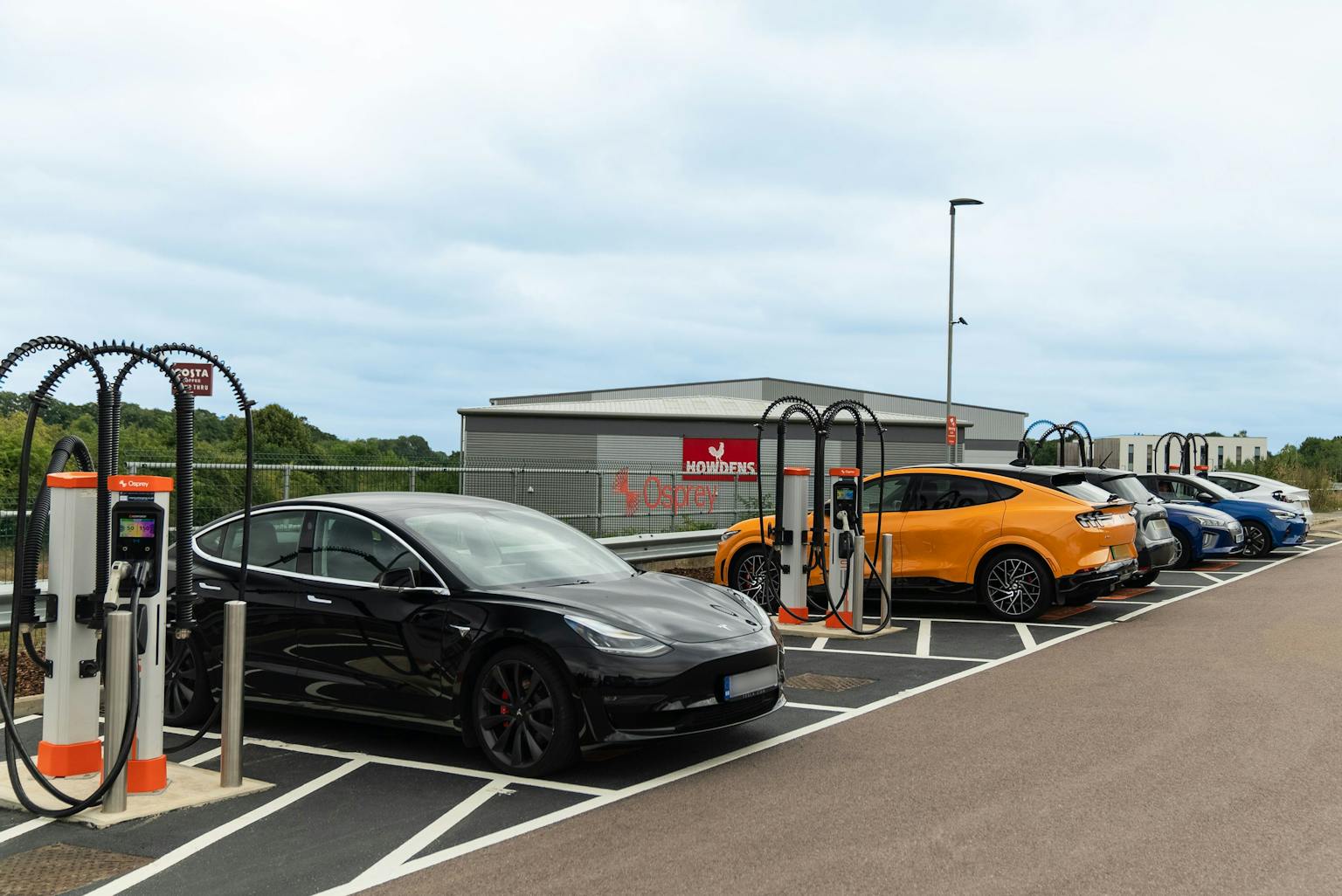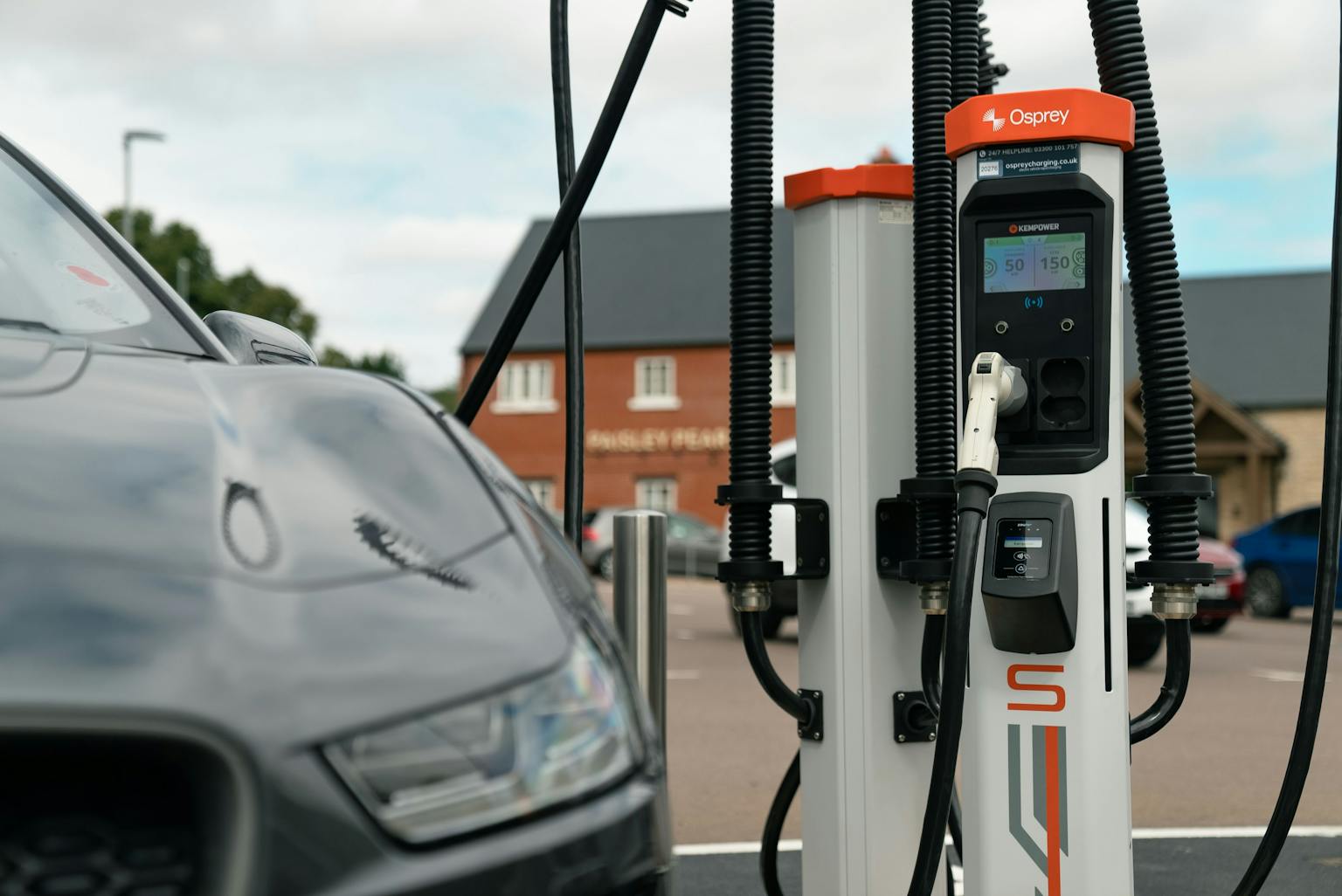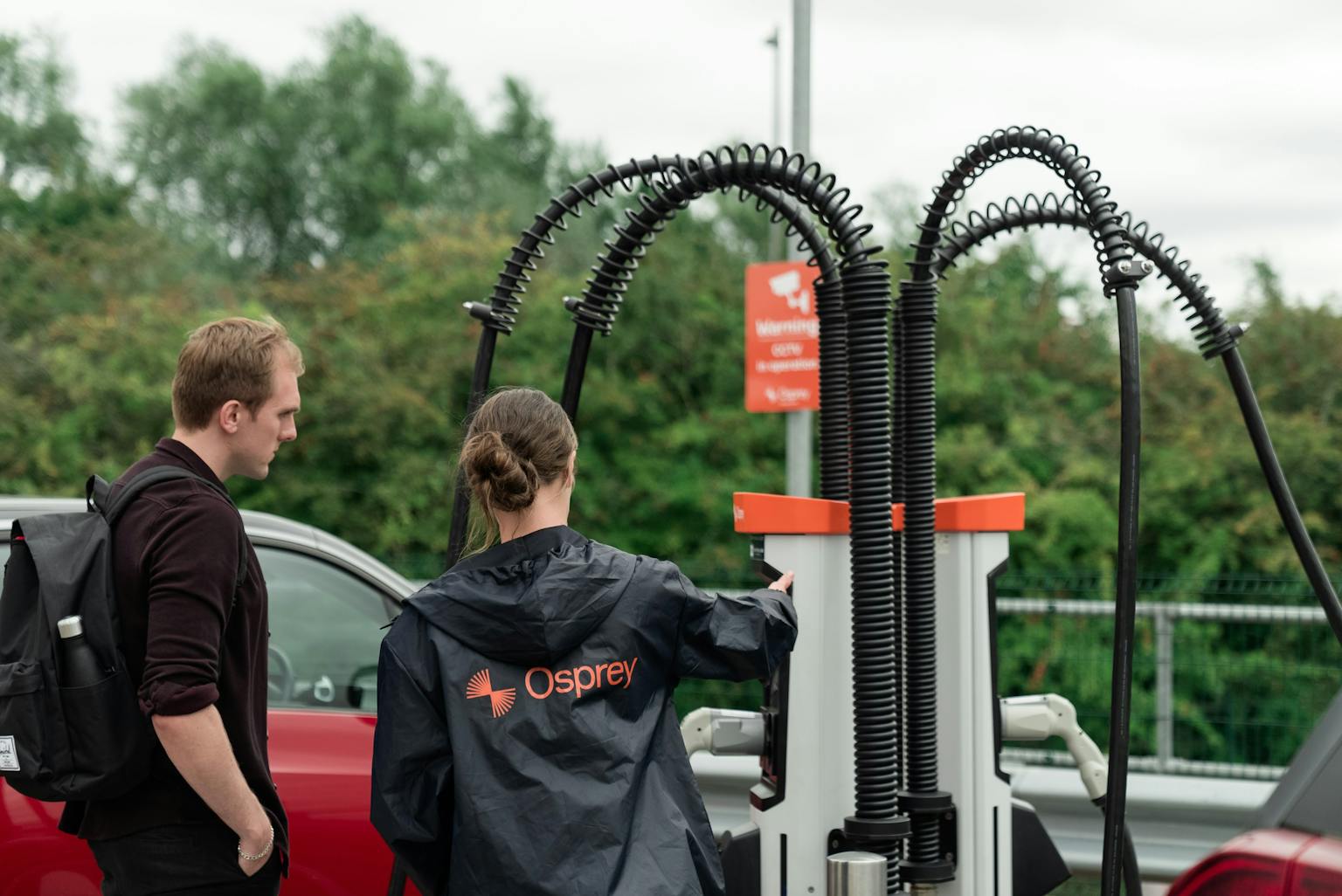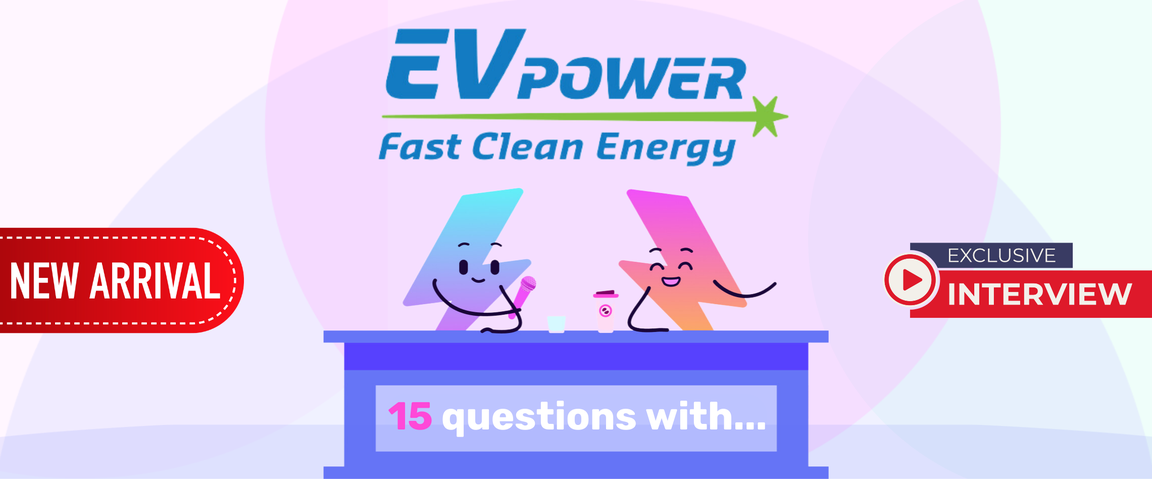April 2023
|Last updated:April 2024
Charged: 15 questions with... Osprey Charging
As one of the largest and fastest-growing rapid charging networks in the UK, Osprey Charging is making a splash with EV drivers - with particular emphasis given to their access for all drivers policy, ensuring EV charging is accessible for everyone.
We sat down with Ian Johnston, CEO of Osprey Charging, to discuss the future of EV adoption and what this means for networks like Osprey, how the EV community is considered in all matters, and what's coming up for Osprey in the near future.
Don't forget! Octopus Electroverse customers get 20% off Osprey chargers every day, between 7 - 11pm. This is a unique pricing trial - a great step towards cheaper and smarter energy usage when charging on the go.
Let's get plugged in...
Give us a bit of background - how did Osprey start?
Osprey started life as Engenie in 2016 with a pilot of six rapid chargers with Cheshire
East Council is the UK's first to have integrated bank card readers. In 2018 we secured significant investment from Investec, and then again in 2019 from Cube Infrastructure Managers, to fund the nationwide network rollout.
Where was the first Osprey EV charging site, and how many charging sites do Osprey now operate?
The first Osprey chargers were installed in Cheshire East across three different sites and were quickly followed by an installation in the Fleet town centre car park.
Today, we have over 400 chargepoints across the UK spanning Cornwall to Perthshire, Carmarthen to East Suffolk.
Find your nearest Osprey chargepoint on the Electroverse map.
Osprey has seen a huge amount of EV community support and success over the years. What do you attribute this to?
I think it comes down to every member of the team putting the driver at the centre of every decision, and taking every opportunity to engage the driver community whether on-site, on social media or at events. It’s also critical that we take driver feedback seriously - there is no point in building a network that drivers don’t want to use, so we have to listen and respond!
Your ‘Access for all drivers’ approach is something widely spoken about in the EV community. How does Osprey ensure that chargepoints are accessible for all?
All of Osprey’s new sites, whether high-power charging hubs or urban compact sites are designed to improve physical accessibility as much as possible, whilst maximising the provision of charging in the space granted to us by the landlord.
We actively use the PAS 1899 standard alongside direct customer feedback to determine our site designs and charger hardware choice. They say that imitation is the greatest form of flattery, and we have now seen other CPOs using the same layout designs.
We are also auditing all older sites for compliance with the new standard and where possible reconfiguring the site design to improve accessibility.
Access for all doesn’t just mean site design. We are leaders in roaming and interoperability, giving drivers a number of ways to pay for charging on our network. Whether that be fleet fuel cards, contactless bank cards or Octopus Electroverse, drivers have the flexibility and can transact in the way that suits them when using the Osprey network.
The EV charging industry has seen a boom in recent years. How has the industry changed since Osprey first started, and how has Osprey adapted to remain a top-rated network?
In the early days, we found ourselves having to convince retailers that the EV revolution was coming, but the 2030 ban and the pandemic have resulted in the Net Zero agenda becoming a priority for every business, so we now have new businesses every day reaching out for Osprey’s expertise on delivering charging infrastructure.
Driver expectations have also changed hugely as EVs go mass market: the CPOs enjoyed great levels of patience and understanding from the early-adopter drivers, but the mass market drivers rightly expect a charger to work first-time every time – and so it’s essential that charging sites are easy to find, easy to pay and easy to charge. Osprey has adapted particularly well to the demand for a better experience.
We have a few legacy charge points, choose leading hardware to install, and above all, prioritise location, space, access and safety on all sites.
As we know, EV adoption is going to grow massively in the coming years - how is Osprey preparing for this influx in charging demand?
Our business has shifted in anticipation of this explosion in demand, and we are now delivering several high-power charging hubs in major transport routes, with multiple high-power chargers in each location. Indeed, the Osprey network will more than double in size in the next 12 months alone. To support this and to ensure our reliability as we grow, we took the decision a couple of years ago to develop our own software platform, which gives us complete control over managing and monitoring our charge points and associated customer services (accounts, billing, support, etc).
When building a new charging site, what does Osprey prioritise?
Driver experience is always the first thing we think about. Before we even get to the point of building a site, we are assessing potential partners and locations and thinking ‘Would I want to spend time here? Would my children? My wife? My grandparents?’ If the location is busy, safe and spacious, we then work with the landlord on a site design that optimises driver experience whilst meeting their requirements and the specifics of that site. We look to deliver the greatest power to the largest numbers of customers in a dwell time that matches the site and is possible with the available grid.
What charging speeds do Osprey currently offer, and what’s the future looking like for faster charging?
Our network has chargepoints from 7 kW through to 175 kW, determined by the natural dwell time that a driver would want to spend at each site. At Osprey we put a real emphasis on choosing the right charging speeds for each location and maximise the number of customers we can satisfy on the available grid connection. If you are visiting a supermarket, you can’t move your car halfway through the charge because it's full and blocking availability. On the other hand, if you are charging en route you want a high-power charge so that your car is nearly full as soon as you have popped to the loo and grabbed a coffee.
We believe the future is in ‘dynamic load-balancing, and we are installing this at our hubs (and are the first in the UK to do it). This means that the available power at a site is not tied up in individual charge points, but stored centrally and distributed in real-time to cars as they need it, via smaller charger satellites. More satellites can be installed than traditional chargers on the same grid connection, so more drivers are served and no power is wasted!
What’s the vision for Osprey in 5 years? Any plans for international expansion?
Our vision is to lead the transition to electric by building and running the UK’s highest quality rapid network. By providing a reliable and easy experience, and even an enjoyable break for your journey, we remove a huge barrier for drivers making the transition to electric vehicles.
Why are partnerships like Osprey and Octopus Electroverse crucial to the public charging infrastructure?
Partnerships that simplify the perceived hurdle of public charging are crucial to encouraging drivers to go electric. Octopus Electroverse supports drivers to use their EV on all their journeys, making use of the public charging infrastructure. Whilst roaming solutions had existed before, Octopus and Osprey pioneered the consolidation of home and public charging onto one bill. As well as simplifying, these innovations drive further creativity and customer-centric solutions – and that is crucial to public charging infrastructure meeting mass-market driver expectations!
About you...
What’s your dream electric vehicle?
It still has to be the Porsche Taycan, but given the reality of life with two kids and a dog, I think the Volkswagen ID.Buzz might be a better target for the near future!
What’s your longest journey in an EV - can you share the total mileage?
I recently completed a 400-mile round trip for a family wedding, and regularly make the 175-mile trip back to my family in the West Country. Travelling with kids and a dog pushes the user case of what a great charging site really needs so it’s a good test of where we need to be.
To read more EV-driving stories, check out our Electroverse community section. One of our members journeyed from London to Montenegro (3,500 miles) in an EV!
Do you have an EV life hack to share with the EV community?
Pre-heating the car before a long journey not only makes it nice and toastie but also warms the battery so that you can enjoy even more range from your vehicle.
What's one piece of advice you'd give to someone looking to use the public charging network for the first time?
We are lucky to now have known reputable and nationwide networks, so don’t gamble on your journeys – stick to the networks like Osprey who are trusted by the EV drivers who have trodden the path and done the learning for you.
And finally - an EV etiquette question - what would you say is the golden rule to using a public charger?
If everyone who bought a new car could be told by the dealer that they only need to charge to 80% on a public charger, it would make a huge difference to other drivers.
Fancy learning more? Read our other interviews with:
MFG EV Power
Source London
Fuuse
Evyve
Connected Kerb
Feeling enlightened or do you think something was missing? Let us know by sharing your feedback.
Interested in learning more? Head over to our Electroverse Community area for more electrifying content.











